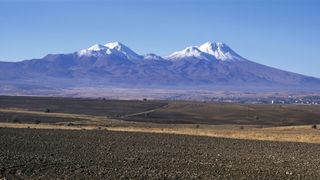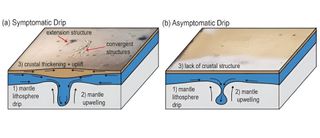Earth's crust may be building mountains by dripping into the mantle
An odd phenomenon called lithospheric dripping might occur wherever mountains form.

Earth's crust may "drip" into its middle layer under growing mountain ranges.
This odd process, called lithospheric dripping, has been proposed to occur under the Andes, in Central Asia, in the U.S. Pacific Northwest and along the west coast of Canada. Now, researchers have found that the Anatolian plateau in Turkey is undergoing a similar process.
The findings could reveal how mountains and basins are built on planets like Venus or Mars, where there are no mobile tectonic plates like the ones that crumple into one another to create topography on Earth.
"It's [about] understanding how tectonics might work on planets that don't have plates," said study author A. Julia Andersen, a doctoral student in tectonophysics at the University of Toronto. "Earth is the only planet we know of that has plates in the solar system, but the other planets aren't flat."
Volcanic eruptions can spill lava on these planetary surfaces. But landforms can also be created when the lithosphere, which consists of the crust and the relatively brittle upper layer of the mantle, gets especially thick. Mountains create a lot of pressure on the lower lithosphere. In the high-pressure zones underneath the towering peaks, new mineralization can occur, Andersen told Live Science. Some of these minerals are denser than the mantle below.
"In any sort of physical system, if you have a higher-density material on top of a lower-density material, then it sinks or drips," she said.
Sign up for the Live Science daily newsletter now
Get the world’s most fascinating discoveries delivered straight to your inbox.
But the idea is still controversial, said Mitchell McMillan, a geoscientist at Georgia Tech who was not involved in the research. McMillan also thinks lithospheric dripping is likely happening on Earth, but it can be hard to untangle the signs of possible dripping from the geology created by the tectonic plates' horizontal movements.

One possible sign is that lithospheric dripping can pull the crust above into wrinkly ridges and valleys, forming small-scale mountains. In Turkey, though, there was no such telltale sign of hidden dripping. Previous research had shown that seismic waves traveling through the crust under the massive Anatolian plateau moved faster than average, suggesting some difference in density and temperature in those areas. At the surface, the only indication that something odd might be happening was the Konya Basin, a vaguely circular basin of about 1,620 square miles (4,196 square kilometers) in the southern portion of the plateau.
Andersen and her team conducted a geophysical analysis of the basin's topography and set up a lab-bench experiment to mimic the formation of this large depression.
They used a thick, gooey polymer to represent the middle mantle, and a mix of clay and the polymer for the more rigid upper mantle, topping it off with a silica-and-ceramic "crust." When left to sit, the clay-polymer layer began to drip into the faux mantle. Notably, the "crust" on top wasn't disturbed. Over time, a second drip event began, still leaving the surface unmarred.
The analysis of the real Konya Basin indicates that the same thing is occurring there, Andersen said. "The data indicated that, yes, there is a drip happening there, even if we aren't necessarily seeing many features in the crust that would indicate that it's happening," she said.
This method allowed for more detail than computer modeling alone would show, McMillan told Live Science. "Physical models like Dr. Andersen's are great because they show some results that our numerical models wouldn't be able to resolve," he said. "This is important for interpreting existing data."
The study, published Sept. 13 in the journal Nature Communications, suggests that a similar process could occur around many mountain ranges around the world, Andersen said. Next, she'd like to investigate lithospheric dripping under the Appalachian Mountains, which were once at least as high as the modern Himalayas.

Stephanie Pappas is a contributing writer for Live Science, covering topics ranging from geoscience to archaeology to the human brain and behavior. She was previously a senior writer for Live Science but is now a freelancer based in Denver, Colorado, and regularly contributes to Scientific American and The Monitor, the monthly magazine of the American Psychological Association. Stephanie received a bachelor's degree in psychology from the University of South Carolina and a graduate certificate in science communication from the University of California, Santa Cruz.